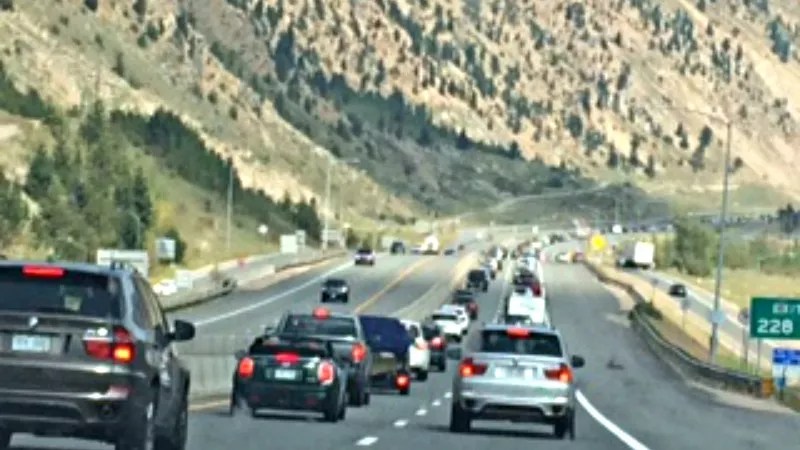
Colorado Department of Transportation

Audio By Carbonatix
As we noted in this space last year, the Interstate 70 express toll lane near Idaho Springs has actually reduced mountain driving hell. But that doesn’t mean the traffic situation from Denver into and out of the mountain corridor is anywhere near acceptable, especially on summer holidays like the just-concluded Labor Day weekend, as my loved ones and I learned through bitter personal experience.
On Friday, September 1, the clan planned to gather at my wife’s family cabin on the Western Slope’s Grand Mesa. We traveled in two vehicles, with my wife and I (accompanied by Sonny, our ancient Miniature Schnauzer, and Lucy, our clinically insane Goldendoodle) in our fabulous Mazda5, and my son, his significant other, my daughter and a good friend carpooling from the Whittier neighborhood in a Subaru Forester. But my wife is a principal at a local school, and because of what is euphemistically referred to in the education field as a “situation,” we were unable to get started as early as we’d hoped, only hitting the highway near our home in the Ken-Caryl Ranch area at around 4:35 p.m. And work schedules for members of the second crew pushed their departure time past 6 p.m.
As a result, both groups found themselves in the motoring equivalent of an oil painting. For us, volume on C-470 was heavy in a foreboding way, and by the time we hit westbound I-70, traffic was flowing like molasses during a February freeze. Cars were bumper-to-bumper and moving inches at a time, giving us plenty of time to assess our progress, or lack thereof. At one point on Floyd Hill, my wife announced that it had taken us eight minutes to travel one mile.
Which means we were moving at eight miles per hour, I think, but don’t hold me to that. Math was never my specialty.
This scenario continued until the approach to the Eisenhower Tunnel, when tires on vehicles finally began rolling too quickly to read the brand names emblazoned on them – and we reached Silverthorne at a little after 7 p.m. On a good day, we’re able to make this drive from our home in a little under an hour. On Friday, it took us about two and a half hours, and while we hadn’t planned to stop there initially, doing so had become a necessity. By that point, the dogs were about to pop, and so were we.

Our view on I-70 eastbound near Georgetown on September 4.
Photo by Deb Roberts
After engaging in some bladder relief and getting something to eat, we continued to the Grand Mesa, experiencing normal conditions the rest of the way. We arrived at our destination at approximately 10 p.m., or somewhere in the range of two hours later than we would have if our commute had been relatively clog-free. And the rest of our party didn’t roll up to the cabin until nearly midnight because of conditions very much like those we witnessed, but even worse.
Saturday and Sunday were blissful – little driving and a lot of nature-enjoying. But come Monday, we made the kind of decision that all of us hated but each understood: Instead of hanging out at the Grand Mesa for a few more hours, we got ready to go early in an effort to avoid the kind of traffic nightmare visited upon us just three days earlier.
This time, we began our journey at 8:35 a.m. – even sooner than we had planned – and sailed along at a fairly rapid clip for a couple of hours. But the number of other cars on the interstate (not to mention giant trucks and overburdened motor homes struggling with the grade) began to build as we approached Vail. On the rise up the pass, our progress was far from smooth, and ascending to the tunnel was even worse thanks in part to another rant-worthy issue, slow drivers in the fast lane. Indeed, we actually made better time by sticking to the right-hand lane, from which so many drivers bailed under the mistaken assumption that the vehicular equivalent of snails would stay where they belonged.
No such luck.
When we saw the first sign announcing the express toll lane, a driver near us showed his eagerness for entering it by switching on his turn signal more than a mile early. At that time, the price for the privilege was $6, and plenty of folks were willing to pay it – so many, in fact, that the speeds in the other two lanes were mostly in the forties and fifties. This stretch was the main reason we pulled into our driveway after about four and a quarter hours. That was between 45 minutes and an hour longer than we would have liked, but far better than Friday’s drive.
Of course, people who stopped their recreational activities after we did were stuck in traffic for a lot longer, thereby ending their Labor Day weekend on a note that was more sour than necessary. Clearly, the express toll lane hasn’t solved all the problems along the mountain corridor, and more imaginative solutions are needed.
Because enjoying Colorado on Labor Day shouldn’t be this much work.